-
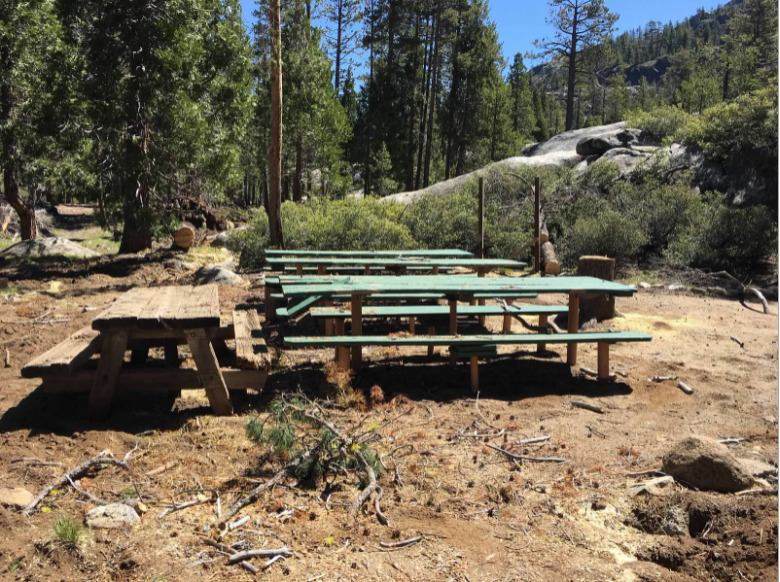
2021-05-26
This is a photograph of the Boucke campsite at Camp Wolfeboro in 2021, before camp had opened to any Scouts. There is a variety of natural debris on the ground, including pine needles, pine cones, and branches. This debris had to all be cleared off of the ground before camp started because this is a campsite used by Scouts and Scouters. The week of May 26 was "Chainsaw week #2", where volunteers went to camp and helped prepare camp to be ready for Scouts to arrive.
The photo was taken during the week of May 26, 2021, and was submitted to the Camp Wolfeboro Shutterfly site by Chris Chapman, who is on the properties subcommittee for the Golden Gate Area Council, which owns Camp Wolfeboro.
-
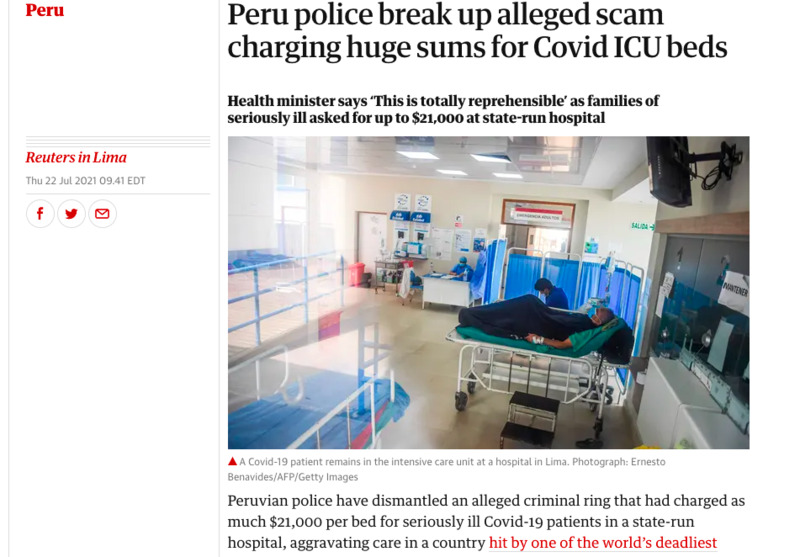
2021-07-22
Hospital beds and medical supplies face enormous pressure with the ongoing pandemic. This article indicates that hospital staff were charging over $21,000 for an ICU hospital bed, a scheme that was broken up by the Peruvian police. If one hospital has been caught, how rampant could this practice be? Also, how can the average Peruvian afford such astronomical prices? The fees and the fact that people paid them show the disparity in healthcare access between Peruvians of means and those without.
-
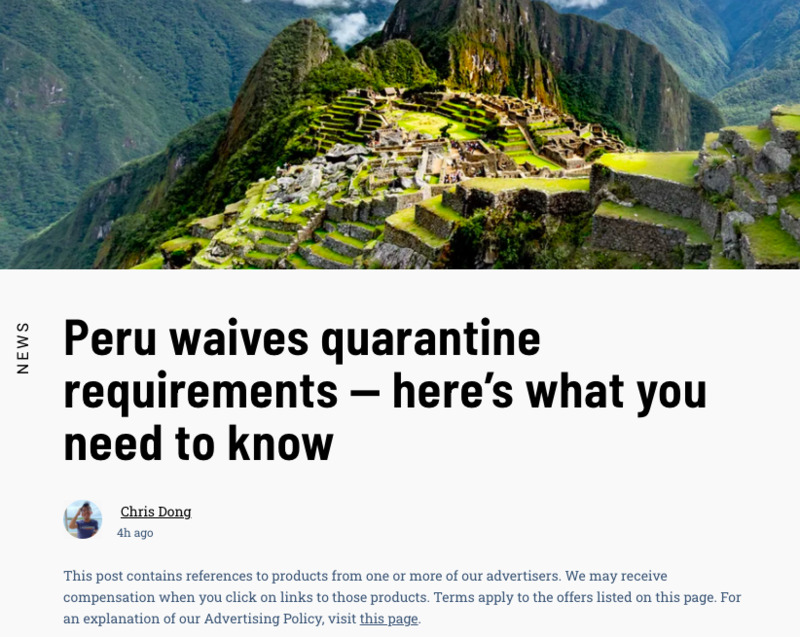
2021-03-18
Peru, which continues to suffer from high COVID-19 transmission rates, has lifted quarantine restrictions for international travelers. The Peruvian economy has been undermined by a loss of tourism, its affected restaurants, hotels, guides, transportation, and other facets that depend on foreign capital. The only catch is that you have to have a negative COVID-19 test 72 hours prior to arrival. All of this hints at the importance of money and influence after all-it's mostly wealthier travelers who would have the money to travel for leisure and access to COVID testing. But...what about everyone else on the plane?
-
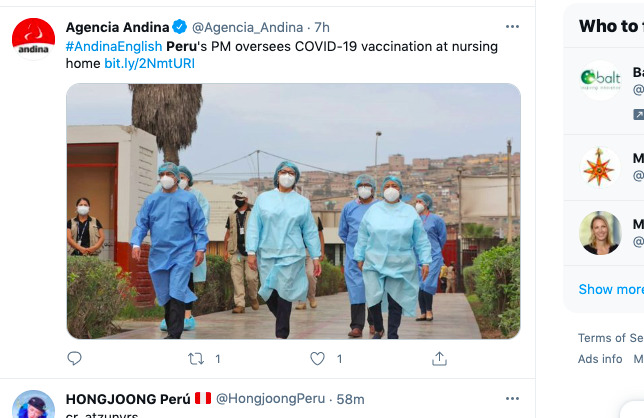
2021-03-16
Peru's prime minister Violeta Bermudez oversees vaccinations in a nursing home. Part of the rollout in Peru.
-
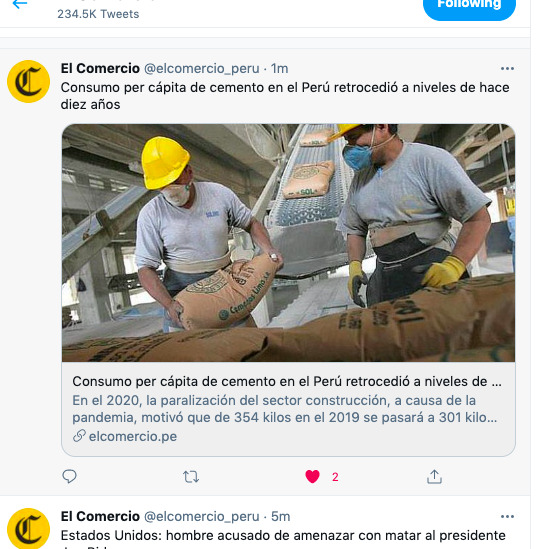
2021-03-16
The cement industry has always been stable, expensive, and increasing. In urban areas, space is precious and construction is costly. This article is very telling of how the pandemic has affected the construction industry and cost of materials
-
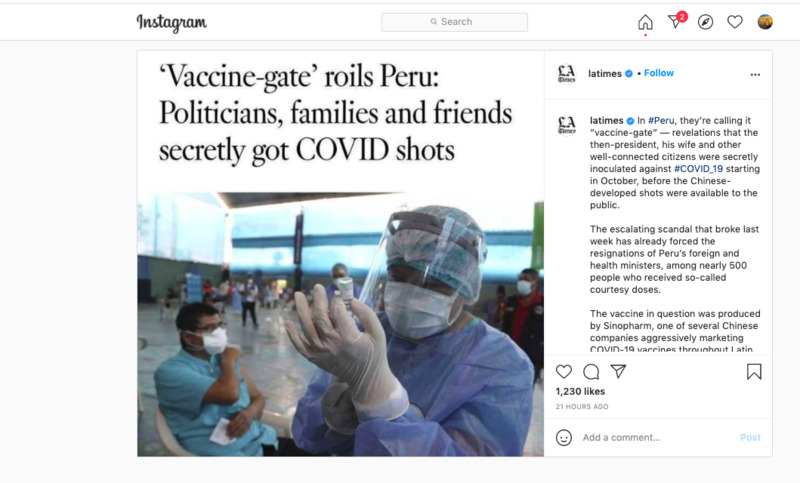
2021-02-18
Peru's president, wife, and other well-connected politicians were getting the COVID-19 vaccine back in October, provided by the Chinese company Sinopharm. The vaccines were distributed before the vaccine was publically available, and some high-level officials have resigned.
-
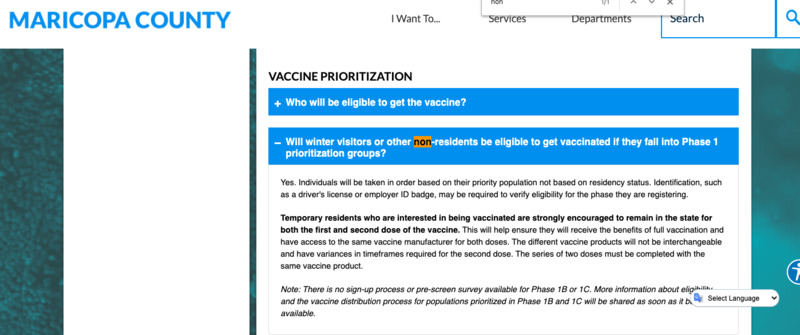
2021-01-27
I've been afraid to ask this question. Can you get a vaccine if you're not a U.S. resident? My mother-in-law has been more or less stuck here since last February. She came from Peru to help watch our 2 year old and planned to stay 6 months, per her visa allowance. WIth COVID, we applied for an extension, and we haven't had an update on her application yet. I do want her to get vaccinated before she goes home, and this information on the Maricopa County website is reassuring that she'll be allowed to get one before she goes home.
-
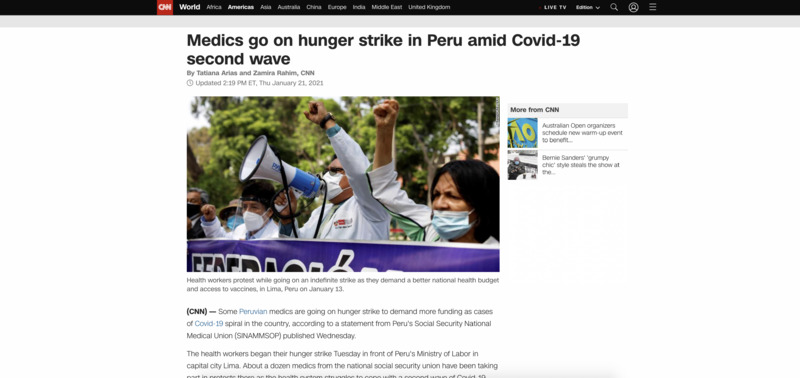
2021-01-21
Peruvian medics and health care workers are on a hunger strike to call attention to the need for further funding as the country struggles with its second wave of Covid-19. There is also a call to remove the country's Health Social Security, Fiorella Molinelli, over the mismanagement of Covid health and isolation centers, but Molinelli has yet to respond.
-
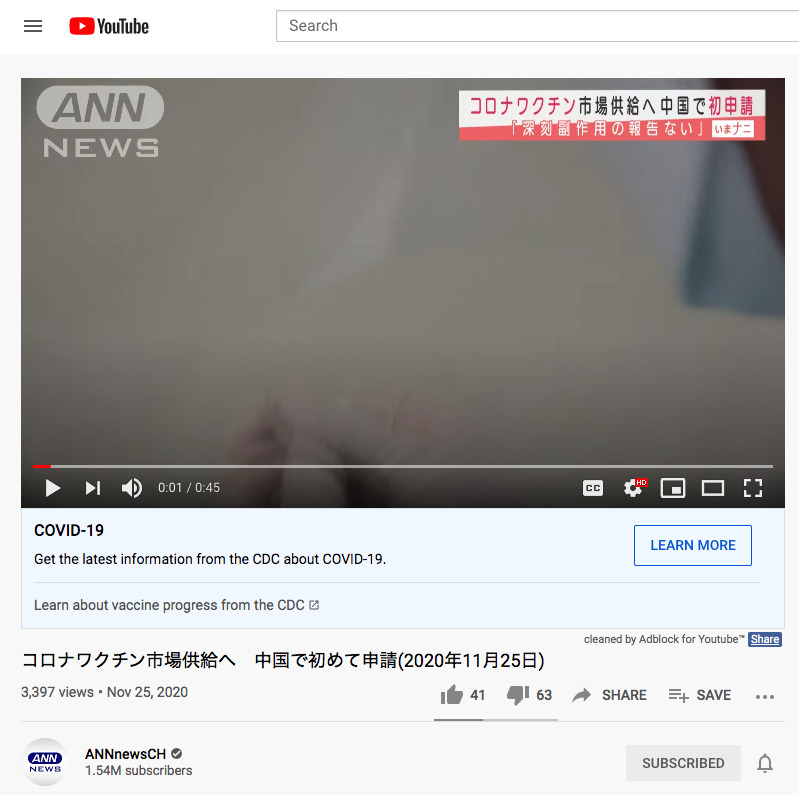
2020-11-25
中国で初めてワクチンの市場への供給許可が申請されました。 中国メディアによりますと、国有の製薬大手「シノファーム」は7月からすでに緊急的な投与を開始している開発中の新型コロナウイルスのワクチンについて、市場への供給許可を当局に申請しました。シノファームは現在、南米のペルーなどで最終となる第3段階の臨床試験をしていて、当局はこの結果を踏まえて許可を出すとしています。シノファームは「100万人近くにワクチンを緊急投与したが、深刻な副作用の報告は1件もなく、ほんの少数に軽度の症状がみられた」と説明しています。
For the first time in China, an application of license to supply vaccines to the market has been put in.
According to the Chinese media, the state-owned pharmaceutical giant "Sinofarm" has applied to the authorities for permission to supply the new coronavirus vaccine under development, which has already started emergency administration since July. Shinofarm is currently conducting the final third-stage clinical trials in Peru and other parts of South America, and the authorities will issue a permit based on this result. "We urgently administered the vaccine to nearly one million people, but there were no reports of serious side effects, and only a few had mild symptoms," explains Shinofarm.
Video translated by Youngbin Noh
-
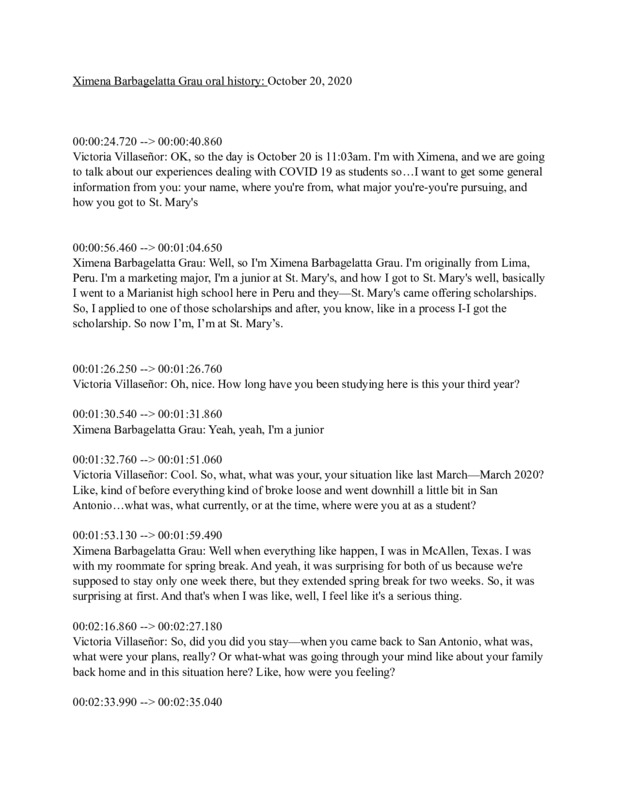
2020-10-20
This is an oral history with Ximena Barbagelatta conducted by Victoria Villaseñor. Ximena Barbagelatta is a foreign exchange student from Lima, Peru studying at St. Mary's University in San Antonio, TX.
-
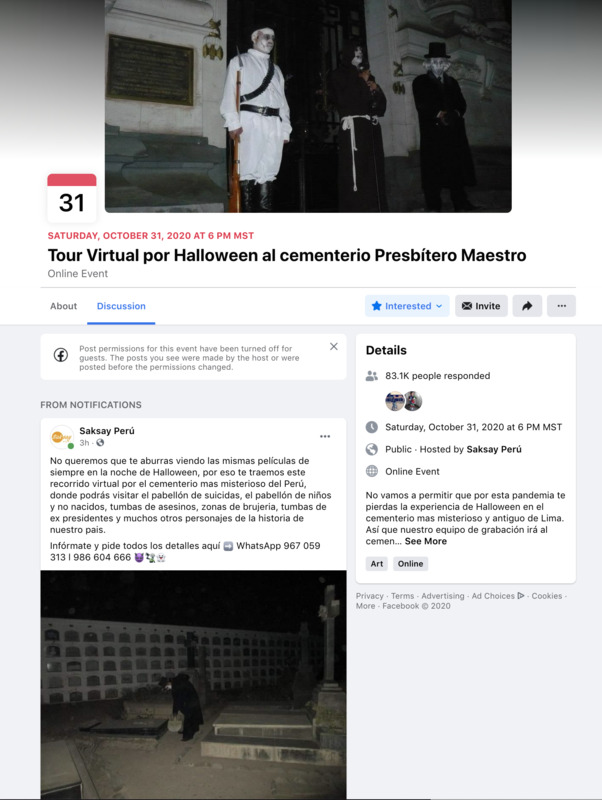
2020-10-31
Evento virtual para celebrar Halloween en Lima, Perú. Están ofreciendo un tour virtual del cementerio Presbítero Maestro. Por s./ 19 se pueden recibir un enlace para visitar el pabellón de suicidas, el pabellón de niños y no nacidos, tumbas de asesinos, zonas de brujería, tumbas de ex presidente y más. Los datos son lo siguiente:
No vamos a permitir que por esta pandemia te pierdas la experiencia de Halloween en el cementerio mas misterioso y antiguo de Lima. Así que nuestro equipo de grabación irá al cementerio esa noche para traerte este recorrido virtual EN VIVO para que lo disfrutes desde donde estés, con la misma chispa y emoción como si estuvieras allí.
-

2020-10-13
A Japanese tourist, Jesse Katayama is Stuck in Peru during the pandemic. He has been allowed into the ruins of Machu Picchu after a seven month wait. Stuck in Peru since mid-March, he was only allowed to enter the Inca Citadel on special request. There are 33,305 deaths because of Covid-19, which is the highest per capita mortality rate.
-
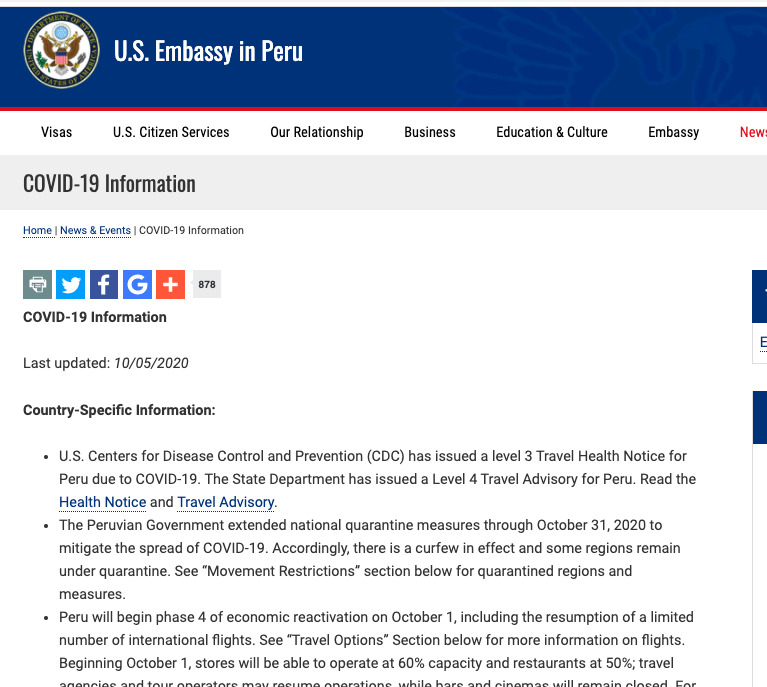
2020-10-12
My mother in law came to Arizona from Arequipa, Peru in Febuary. She arrived a few days before the news of Coronavirus seemed to be spreading in the United States. She has been an absolutely lifesaver. Without her, I don't think I could have managed, especially once school was effectively cancelled for my kindergartener in March. Having my mother in law around is like having another mother, another set of hands to help. She is pretty active and mobile, so she doesn't mind keeping up with the 2yo and she helps me take care of all those details around the house that I never have time for like cleaning, washing dishes, letting the dog out, letting the dog in, breaking up the fight between siblings, cooking, all of it. Now we split most of those chores, since my husband works outside the house.
I couldn't do it without her, and I should say that we don't take it for granted. We pay her what we would have paid the daycare for the 2yo, which is actually a decent weekly income when translated back to Peruvian soles. This image shows that there are limited flights back to Peru and that Peru is still in a waves of curfew and lockdowns. We've applied for an extended visa, and I'm hoping she can stay through December. I know she misses home, but she's also glad to be useful and to be living somewhere that isn't enforcing curfews and periodic lockdowns.
-

2020-08-06
A meme from the Being Peruvian Instagram account, it shows the risk of getting sick with or without a mask, and jokes about not liking/eating ceviche.
-

2020-09-06
Meme from Being Peruvian Instagram. It makes light of how inactivity leads to weight gain during the pandemic. Peru has some of the strictest lockdown orders, and it's a society that is accostomed to walking and traveling across the city daily. Loosing daily activity has slowly, but surely affected everyone's health.
-
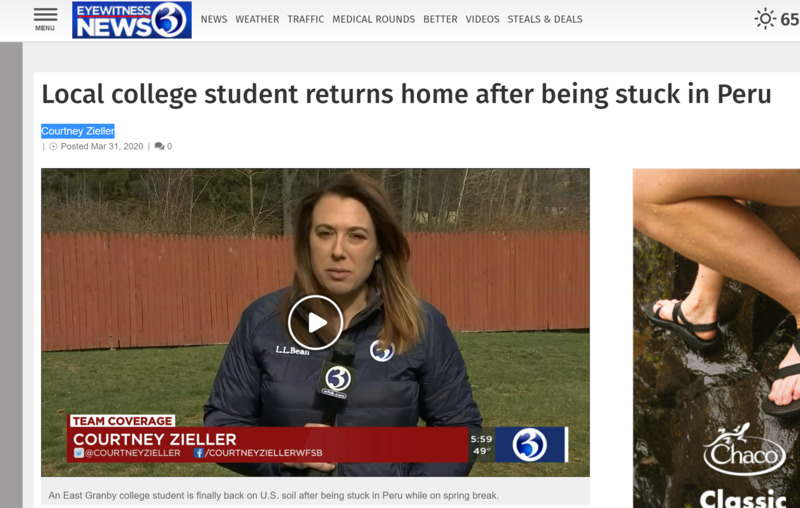
2020-03-06
So I am down in Peru with three fellow students from Wesleyan University. We are just beginning our spring break, and had recently united in Lima before flying together to Cusco the next morning. Our plan was ambitious, chaotic, and irresponsible in hindsight; we had decided to hike the Salkantay Trek from Soraypampa to Aguas Calientes. The evening of our arrival, we were out to dinner when at 9 pm, my friend receives an alarming text from his mother stating that the Salkantay Trek was closed because of a historic mudslide that had decimated the entire trail below the highest pass. This slide sent at least 12 to their death (many remain missing today) while simultaneously displacing 430 families living in the valley. At the time, we were unaware of these disturbing statistics and decided to find a tourist agency that would perhaps guide us part of the way. At 10 pm that evening, we located a random tourist shop that was lightly populated by two employees in the backroom of a jumbled building of interior storefronts. They assured us that not only is the trek impassible at multiple points, but that the Peruvian government was preventing travelers from setting out on the trail. We offered to pay a guide to take us even part of the way, but they turned our proposal down. They did, however, secure us seats on a bus leaving at 5 am the next morning to Soraypampa where tourists engrossed themselves in a heavily assisted day-hike to Lake Humantay. We waiting in the darkness of the Plaza de Armas while bus after bus went to various other locations around Cusco. We dizzily wavered around due to the 11,000 feet of altitude gain that we had assumed less than 24 hours ago until a bus finally came to pick us up. From there, we dangerously (or so we thought at the time) drove through one-lane mountain roads in a loaded bus for nearly five hours. At last, we unloaded and grabbed our packs. We were the only backpackers in sight, and we planned on doing this trek without guidance both geographically and physically. As the rest of the hikers walked packless with sticks to the lake, we lagged behind, destroyed by the sudden difficulty of what was supposed to be an easy first day of trekking. Even with mouths full of coca leaves, two of us required sips of the small oxygen canister we picked up the day before. Our bodies pulsed with symptoms of altitude sickness, but we pressed on. No other view could have made me smile as widely as that of glacial Lake Humantay as we crested the final ascent. At 14,500 feet of altitude, we laughed at the fantastic beauty before us. We had arrived in the early afternoon, and found ourselves almost totally alone beside this pool in the Andes Mountains. Our descent was horrible. Pulsing again were headaches, fatigue, shortness of breath, and swelled joints. In our divergence from the path most traveled, we entered a trail of horse, cow, and llama (domesticated guanaco as we kept on) crap; an uncomfortable rain began to fall, and we found ourselves walking through a mountain feed mist. Within all of our heads was the terrible thought of setting up camp in the rain. Our level of exhaustion was overly evident to any onlooker (there was no one), but as the rain let up and our camp became established, moods lifted and excitement spiked. We were observing the most beautiful sunset display any of us had ever seen. The sun, setting at around 4:00 pm because of the extreme prominence of the surrounding mountains, swirled its orange and pink on the snow-covered top of Mount Salkantay almost as a kind of sorbet is presented at an ice-cream shop. Our wide smiles disappeared as a frigid wind whipped through the valley that we were so exposedly staying in. Dinner in the dark was followed by an unmatched view of eye-contracting stars as we retreated to the chilled interior of our tents. Altitude sickness plagued any chance of a good night's sleep, and we awoke frozen and in a misty cloud. It was this day that we would trek through the Salkantay Pass at 15,220 feet of altitude. Endless switchbacks defined the first half of the day. We toiled over each step, our packs dragging each attempt to press on. After a few hours of extreme exertion and chill, we passed through the highest point of the trek. Once the clouds parted, an incredible view of the mudslide's decimation shocked us into the reality of our unguided trek. The slide refigured the landscape with a melting expanse of boulders climbing both sides of the valley and completely filling in the previous location of the Salkantay Lake. Armed with a compass and an enthusiastic "we can't turn back now" mindset, our trek took us through a few miles of trailless movement into the valley ahead. The rest of this day wasn't by any means forgiving. Passing through a newly abandoned town, over a sea of boudlers and deep, wet sand, and into the jungle valley brought set after set of challenges. Towards hour 11 of the day's hiking, a thunderstorm burdened the final steps we had to take. The valley was steep, and beneath us crept a barren section of forest where the river washed away all vegetation in existence (it rose over 130 feet in some sections). Once we had almost made it to the supposed location of the next town, we hopped another small waterfall and rounded another unpromising corner to see only a gap. For about the length of a track, a secondary mudslide caused by the huge forest laceration made by the river's rise opened up to an impassible section of an unstable dirt cliff-face. We spent the next hour cautiously pressing up and around the empty gap in the forest in the ongoing rain. From there, we very quickly arrived in the next town, populated but in a state of emergency. Their supply of food had been entirely cut off, and reserves were running dangerously low. The following day, we were shown to a couple of provisional bridges that the locals had erected just two days before with some fallen logs and sticks. More treacherous than anything any of us had done, we inched along the sloped, wet logs that stretched over the intersection of two overflowing rivers. Later that day, a mile long mudslide had taken out another part of the trail, but this one was dry and had experienced some local foot traffic (there were no roads for the first four days of trekking). We got ahead that evening, and camped on a man's land high in the valley steeps who informed us that we had been the only group to travel the Salkantay Trek route for the entirety of the year 2020 (this was in March mind you). The next day of trekking was far longer than we had expected, but traveling alone through an ancient village to a phenomenal viewpoint of Machu Picchu made it worth it. We ended in with a beat arrival in Aguas Calientes, but that evening was full of celebration and restaurant food. Two of us woke up with food poisoning, and we decided to travel back to Cusco midday rather than in the evening. Upon arriving at our hostel, President Vizcarra came on the television to announce that Peru would close its airports in 24 hours. At the time of our departure in Soraypampa, the coronavirus had only spread widely in China and Italy, but when we got out, the internet flooded our phones with the reality of online classes, the spread of the virus into a pandemic, and the global closing of boarders. Panic-ridden, we awoke at 5 am to escape the claim that hostels and hotels would be locked from the outside by the police to force a 15-day quarantine period set by the Peruvian Government. We waited outside in the rain until the last flight to Lima departed with us onboard (our ticket had coincided with the last day of open airports by sheer luck). In Lima, we were locked in our friend's house, prevented from going outside by the fear of getting arrested by the endless number of police and military stationed on the streets of the city. Day after day passed, we played chess, meditated, and hoped for an email from the U.S. Embassy of Peru. Weeks passed, and the panic of my family was calmed by my less-bothered conscience. After daily reminders pointing towards the extension of our visit to Peru to months, the housing situation ended for two of us, and we ventured to a nearby hotel to wait out the rest of our stay in Lima. By some miracle, we were then put in touch with a DEA agent helping at the embassy (the DEA helped out because the chair of the embassy and many of his employees all fled back to the U.S. leaving thousands of citizens stranded for much longer). The person who aided us brought us to the embassy to get on a departing repatriation flight as standby passengers. In a rare moment of animation, my friend and I flew on an unfilled flight directly to Washington, D.C. Our trip had ended, but our quarantine in a very strange new world had just begun.
I want to note that I skipped large swaths of experience to fit this shortened story into a mildly digestable piece. I also did not read through it yet so forgive any mistakes or sections lacking flow.
-
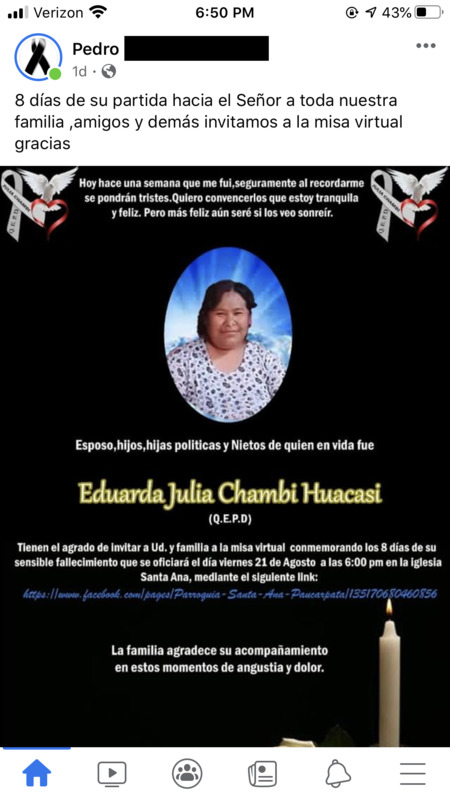
2020-08-22
My husband's aunt died from COVID. She had complications with a previous lung condition, and went to the hospital, but ultimately didn't survive. His uncle held a virtual mass to commemorte her life, held by the Santa Ana church. His uncle is absolutely gutted, and tested postivie for COVID as well. Luckily, he survived, but it pains him to survive without his beloved by his side.
Peru, loss, grief, mass, death, virtual, obituary
-
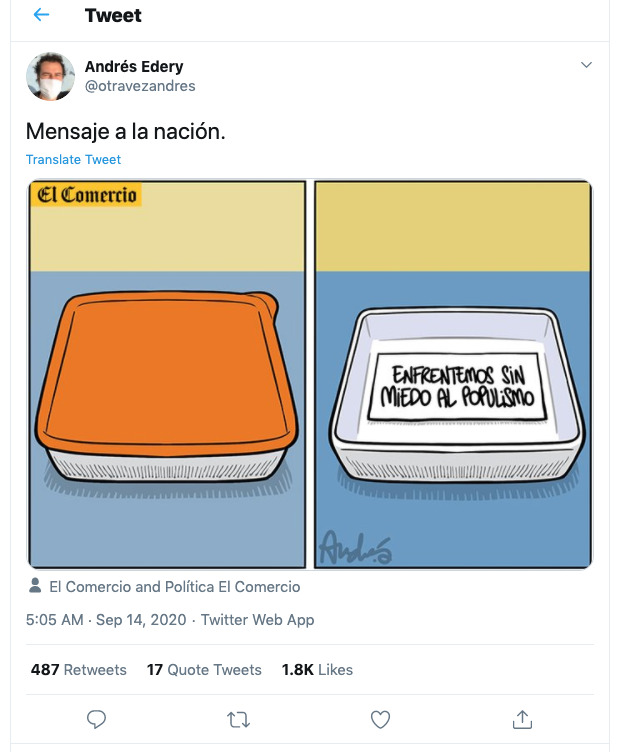
2020-09-14
Otro dibujo hecho por Andrés Edery, indicando que la gente de Peru ya están lista para un sistema populismo. Publicado en el periódico El Comercio. Edery publicó su dibujo en Twitter después de que se publicó en El Comercio.
-
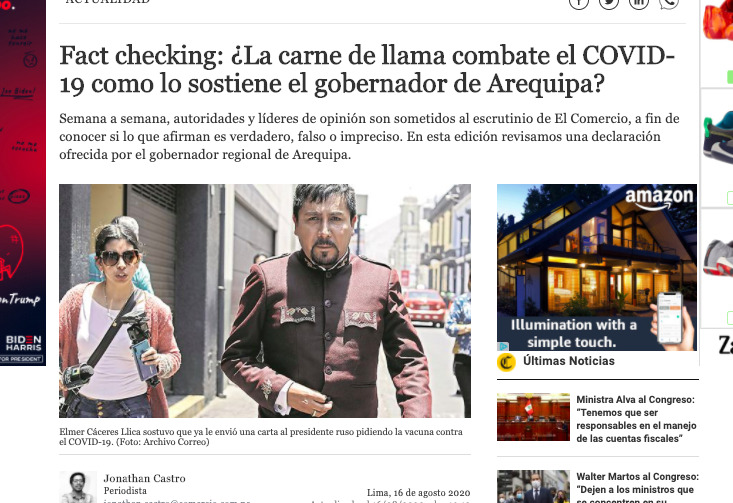
2020-08-16
News article from EL Comercio that fact checks the statemet from Arequipa's governor: “El consumo de alpaca y llama combate el coronavirus. Está comprobado científicamente que combate al COVID-19”. A number of different solutions have been proposed to combat COVID in Peru, but the idea of eating llama meat is one of the strangest.
-
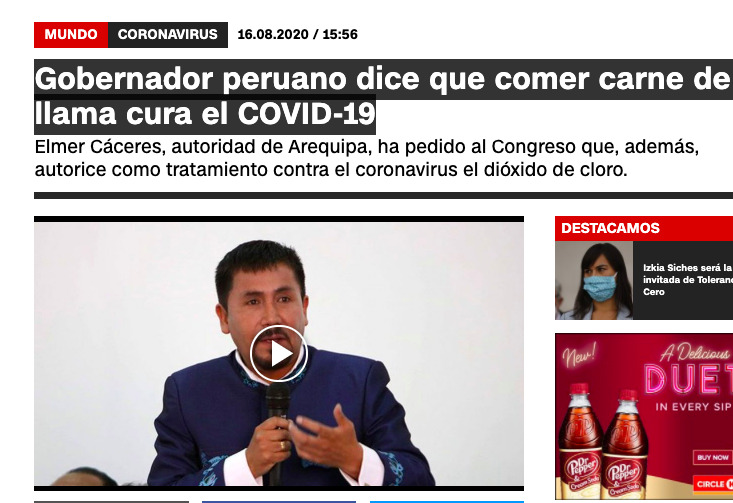
2020-08-16
Carne de llama y dióxido de cloro es la receta sin sustento científico para combatir la COVID-19 del polémico gobernador de Arequipa (Perú), Elmer Cáceres, que ahora pide obtener la vacuna rusa después de que el gobierno peruano lo haya despojado de sus competencias en la administración de la salud.
-

2020-08-12
El gobernador regional de Arequipa, Elmer Cáceres, volvió a hacer de las suyas. Cuando días atrás se mostraba favorable al uso del hidróxico de cloro para combatir al Covid-19, ahora afirma que el consumo de carne de alpaca y llama es efectivo para hacerle la contra a la enfermedad.
«El consumo de alpaca y llama combate el coronavirus. Ojo. La llama, ¡hay que consumir carne de llama!, está comprobado científicamente que combate al Covid-19 que está matando a nuestra gente. Yo invito al pueblo de Arequipa y del Perú a consumir carne de llama, que es brillisimo», manifestó en una actividad pública.
Cáceres Llica dictó esta exhortación a diversos ciudadanos de su región.
Por otro lado, también dijo sostener comunicación directa con Rusia para importar, lo más pronto posible, la vacuna en este país desarrollada, a la región Arequipa.
Todo lo que indica el gobernador es de su propio criterio si bases científicas luego dijieron que lo que dice de la carne es completamente falso.
Fuerte : Orcopampa al día
-
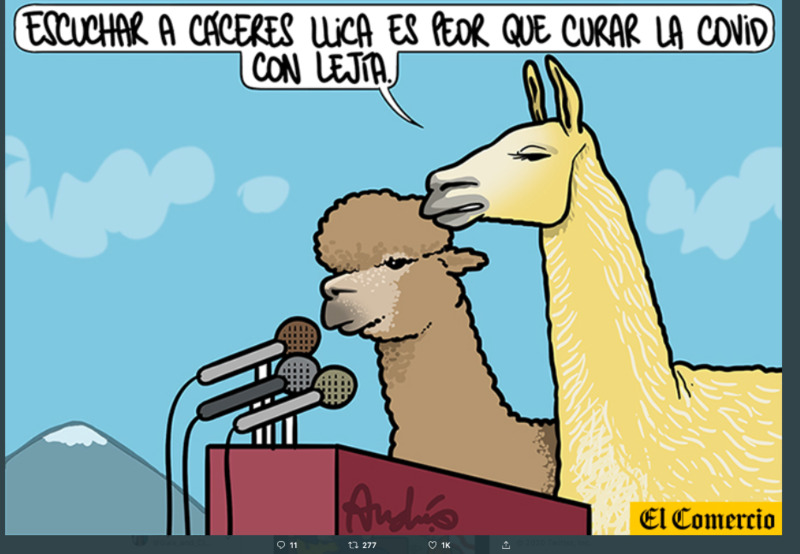
2020-08-18
Cáceres Llica es el gobernador de Arequipa. Últimamente ha dicho o hecho cosas extrañas como escribió una carta a Putin pidiendo que le manda unas vacunas, y hablaba temas populistas como decir que comer carne de llama te puede proteger de COVID. El dibujo implica que escuchar a este político es ignorante como curar el COVID con lejía.
-
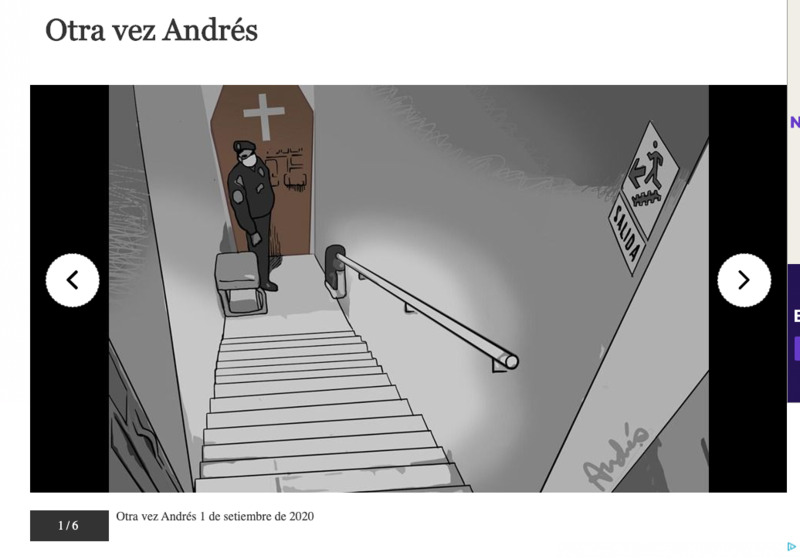
2020-08-28
More political cartoons from artist Andrés Edery featuring humor or at least political cartoons regarding no escape from COVID and the COVID-19 vaccine trials.
-

2020-08-28
La tía de mi esposo se murió hace una semana de COVID en Arequipa, Peru. Ahora, su tío también tiene COVID. Mi esposo llamó a su primo para conversar de los eventos, y grabé la última parte de la conversación. Lo que me impresionó era que decía que había tantas bolsas des cadáveres, y que la gente moría de asusto o paro cardiaco porque el temor les consumía.
-
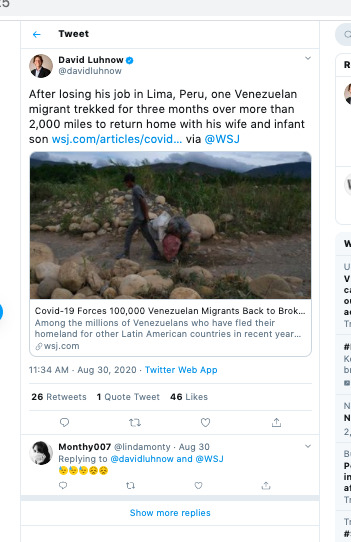
2020-08-30
Over the past five years, Venezuelan migration to Peru has really picked up. With an impoverished country, political corruption, and sometimes no food, Venezuelans have exited in mass. Now with COVID-19, people have found themselves in dire straits and wishing to reverse migrate. This tweet of a WSJ article captures the story of a father and mother who trekked for over 3 months from Peru to Venezuela with their infant son.
-
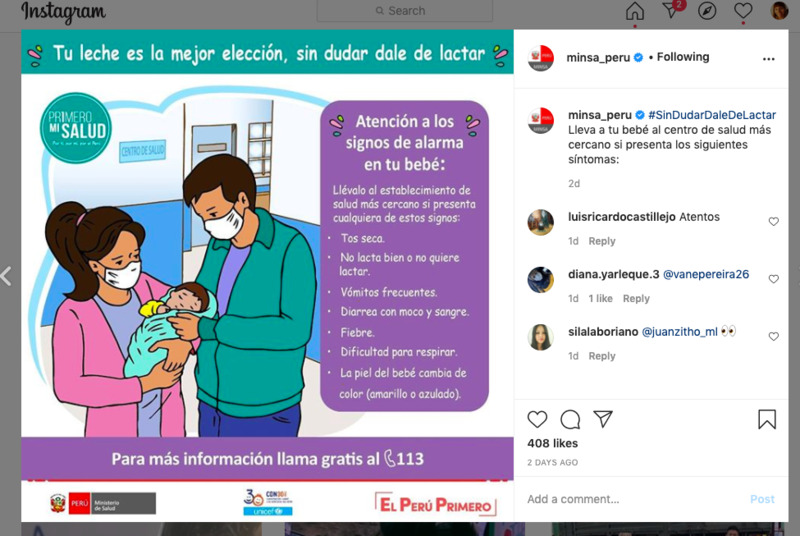
2020-08-22
It’s really interesting to me that this recent public health promotion is advocating for nursing and responding to your baby’s changes. The parents are wearing face masks, so it’s clearly tying into the Coronavirus pandemic and larger public health concerns. From the Instragram account of the Ministerio de Salud del Perú.
-

2020-08-15
Este video fue grabado en día en la ciudad de Arequipa, como se sabe el consumo de bebidas alcohólicas esta prohibido ya sea lugares que estén fuera del hogar o dentro del mismo. Es por esto que algunos jóvenes optaron por celebrar el día de Arequipa en Characato distrito que se encuentra alejado de la ciudad el cual está rodeado de chacras los jóvenes pensaron que no serían atrapados pero al parecer algunas personas dieron aviso a los militares que se encontraban haciendo guardia a alrededores. El hecho ocasionó que al ser descubiertos empiezan a huir del lugar siendo perseguidos por el personal del ejército vecinos del lugar grabaron lo sucedido.
-
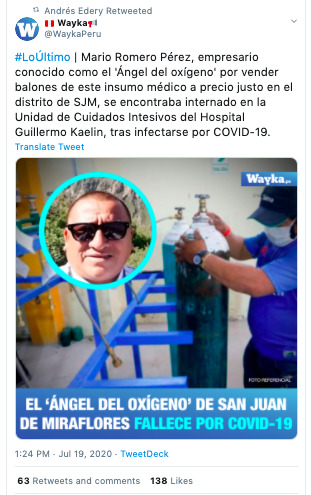
2020-07-22
Mario Romero Pérez, empresario conocido como el 'Ángel del oxígeno' por vender balones de este insumo médico a precio justo en el distrito de SJM, se encontraba internado en la Unidad de Cuidados Intensivos del Hospital Guillermo Kaelin, tras infectarse por COVID-19.
-
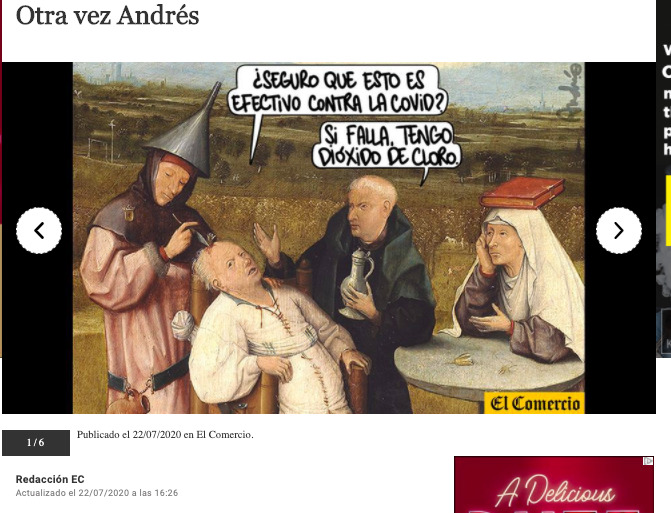
2020-07-22
Daily cartoon from Otra Vez Andrés, showing a man having his head cut open and asking if it's effective against COVID. A man in a black robe answers, if not- I've got chlorine dioxide. The cartoon is making fun of people or at least light of people trying to heal themselves or fortify themselves with ineffective COVID treatments.
-

2020-07-19
Celia Capira y su familia se hicieron conocidos, luego que ella corriera tras la comitiva del presidente Martín Vizcarra que llegó hasta Arequipa. Capira pedía ayuda para su esposo que se contagió de la COVID-19, a quien no recibían en dicho hospital porque no había camas disponibles.
Las autoridades de Arequipa se comprometieron a trasladar a su esposo Mamani Tacuri a una cama en la unidad de cuidados intensivos; sin embargo nunca cumplieron.
Él ingreso el martes pasado por problemas al respirar, fiebre y tos; estuvo esperando por una cama a las afueras del hospital honorio Delgado Espinoza ahí su salud empeoró.
En diálogo con RPP Noticias, Celia Capira manifestó que el personal que atendía a su esposo, en una de las carpas del hospital, siempre le manifestó que él se encontraba estable. “Hoy le llevé el desayuno y me dijeron que estaba estable, con una saturación de 93”.
Ella invocó al presidente de la República Martín Vizcarra que se dote de más personal médico a los hospitales de Arequipa. “Que por favor ponga más médicos especializados por favor, es demasiado este dolor, que haya más medicinas.
FECHA 7/19/20
FUENTE: Frase Corta
-
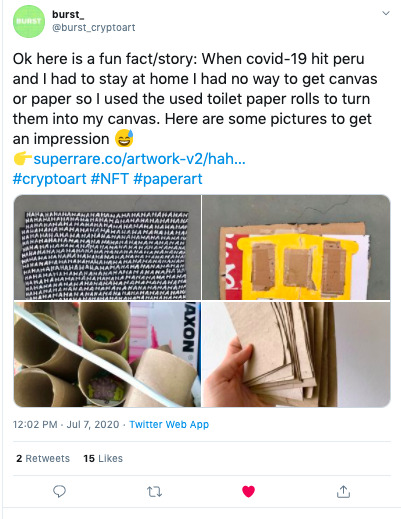
2020-07-07
Here's an artist who got stuck in Peru due to COVID. He couldn't go out to buy paper or canvas, so he used the cardboard from toilet paper rolls. I'm even slightly surprised his toilet paper had cardboard rolls, because a lot of times that part is left out to save costs. Anyway, the digital art he created is pretty interesting, but it's hard to find out more about the artist because he's a self-described as: "@burst_ is an anonymous cryptoartist with an emphasis on post-neoexpressionism and digital art 🖼👾 he creates dystopian-hybrid-organic abstract artworks as well in a digital as physical form..."
-
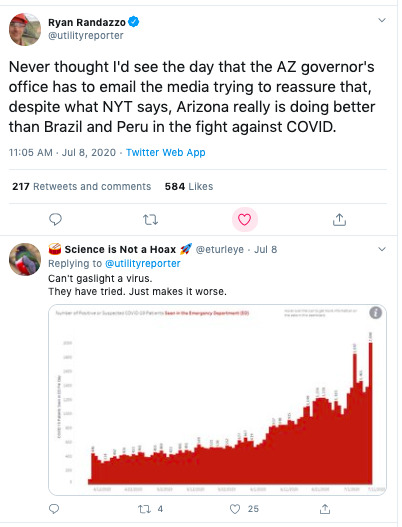
2020-07-08
It's odd that the U.S. response to COVID has been disjointed among national, state, and municipal efforts. Peru had a strong, concerted national effort, but there are so many factors that are contributing to the spiraling infection rate including a day-to-day economy, and the lack of economic support for families. But for officials in Arizona to point the finger and say- hey we're doing better than...seems shameful. Our infection rates could be under control if we followed a systematic public health program. Instead, most businesses are so desperate to reopen like bars and restaurants that they don't really protect customers or staff. The rate of infection among young people started to creep up after Arizona reopened in May, and last week Tempe had to close its bars again to get the situation under control.
-
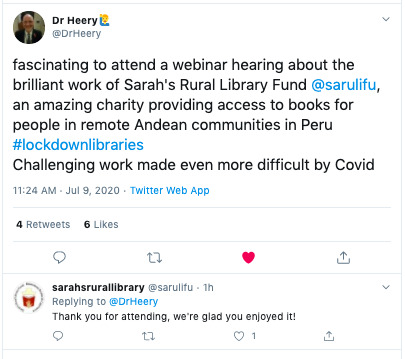
2020-07-09
I saw this tweet about a rural library fund, and thought it was really interesting that there is a charity providing access to books for people in remote Andean communities in Peru. I watched some of the Zoom recording to learn about it, and it seems really encouraging that this type of charity work is continuing despite COVID-19. Providing physical books to students in remote areas is such a worthy cause, and one that can really fracture along class lines due to cost and accessibility.
-

2020-07
En el Perú las realidades sin diferentes, las cuales han vivido de manera diferente la cuarentena en este reportaje se muestra las dos caras de La moneda. Se muestra que las personas de recursos bajos no comen lo mismo que personas que probablemente tienen mayores recursos en este caso se ve que una mujer come arroz con huevo o ollas comunes mientras alguien pudiente como tallarines con salsa y pollo además que no lo preparan ellos sino lo hace otra persona que ellos pueden pagar incluso aún en estos tiempos. Se muestra también que en la actualidad las ollas comunes se han multiplicado a niveles no vistos desde la década de los 80's y 90's. De igual manera se puede observar también como las personas de bajos recursos no cuentan con trabajo, nadie los quiere contratar en sus empresas además había gente que incluso solo vendía papa con huevo en las calles y actualmente no lo pueden hacer por que aún no lo tienen permitido. En cambio las personas con recursos mayores trabajan desde casa (teletrabajo) , se muestra también que incluso no cuentan con agua ni alcohol para lavarse las manos a lo que la otra cara de la moneda siempre tuvo agua en sus casas y incluso llevan botellas de alcohol en gel para desinfectar sus manos en cualquier momento. En Perú y en este caso en Lima se muestra una población muy desigual que en estos tiempos indican ellos mismo "no podemos quedarnos en casa por que si lo hacemos nuestros hijos no comen".
-

2020-06-29
Muchos ambulantes estan sufriendo debido a la actual crisis sanitaria, ya que según el video varios tenían trabajos estables ya sea un negocio propio o trabajaban de meseros entre otros oficios, mencionan también que el virus ha cambiado su vida ya que muchos no comen en la calle por miedo a contagiarse por lo que están de 8a.m. a 6p.m. en la calle, para luego volver a casa con sus hijos, otro problema que los aqueja es que la municipalidad les quita mercadería por que algunas veces no respetan la distancia o se agrupan, lo que genera perdidas que en la actualidad para ellos es muy grave. Para finalizar estas personas reclaman que no accedieron a ninguna ayuda del estado en relación a sus negocios ya que el 71% de el plan para empresas del estado peruano "reactiva Perú " fue dado solo para grandes empresas.
-
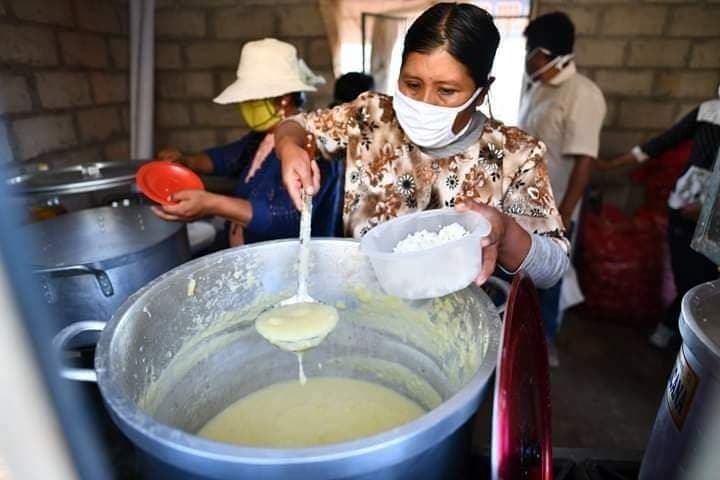
2020-06-26
El llanto de los pobres a 102 días del Estado de Emergencia
Varias familias de la Asociación de Vivienda “Los Heraldos del Cenepa”, parte alta de Mariano Melgar, se organizaron para realizar una olla y compartir un plato con los que menos tienen.
Auto gestionadas, sin colores y con mucho corazón, las ollas comunes son la bandera de lucha de un pueblo capaz de organizarse por sí solo en momentos adversos, y al mismo tiempo son el reflejo más crudo y doloroso de la desigualdad y vulnerabilidad social que a estas alturas es imposible esconder. Ahora estas familias luchadoras piden el apoyo de las autoridades y población para continuar con esta práctica solidaria.
Fuente / Frase Corta
Fecha 6/26/20
-
2020-06-18
En la ciudad de Trujillo se realizó un desfile de modas en plena crisis del Corona virus. El cual fue criticado por todo el pueblo peruano indicando que este acto era algo insensible y peligroso.
El gerente regional de la Producción del Gobierno Regional de La Libertad, Roger Ruiz, aseguró que nunca se tuvo la intención de herir susceptibilidades de las personas, en estos momentos de emergencia sanitaria nacional, con un desfile de prendas de protección para el sector Salud e Industrial.
En diálogo con RPP Noticias, el funcionario respondió tras la serie de críticas que originó un desfile de modas realizado en el patio de la Casa de la Identidad Regional en la que estuvo presente el gobernador regional de La Libertad, Manuel Llempén Coronel.
Roger Ruiz dijo que el único objetivo de la presentación fue mostrar las indumentarias confeccionadas por los pequeños empresarios del calzado e industrial que están pasando una grave crisis económica por el cierre de sus negocios.
Fuente: Espacio Libre
-
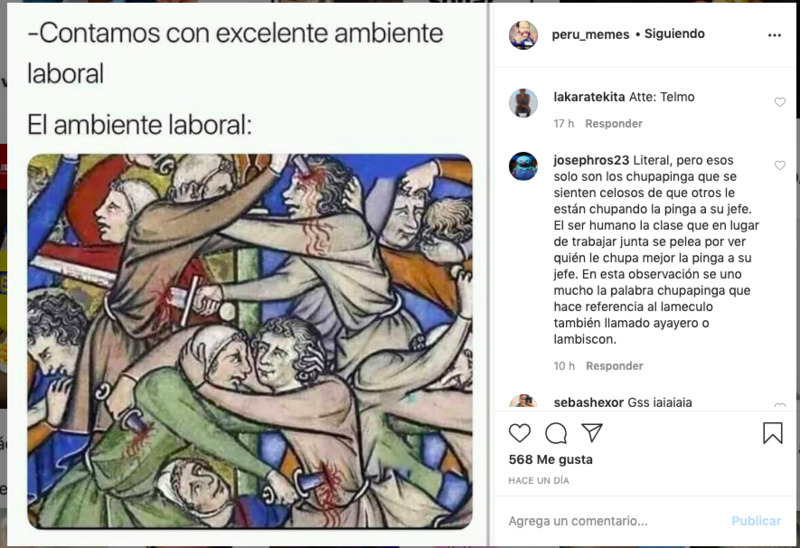
2020-06-23
A meme posted about the cutthroat labor system in Peru, it's true that there's a lot of competition in certain sectors. In some cases, vendors barely make a profit because everyone is trying to offer the lowest price just to make the sale. I often had this conversation with my mother in law who sold clothing on consignment, I understand that consignment is a normal practice, but if you have to take a bus/taxi to someone's house 3 or 4 times to collect installments, the minimal profits you were making are essentially erased. Now that Peru is allowing some vendors to start selling again, it's once again a volatile and competitive environment because so many people have been without work and the basic necessities.
-
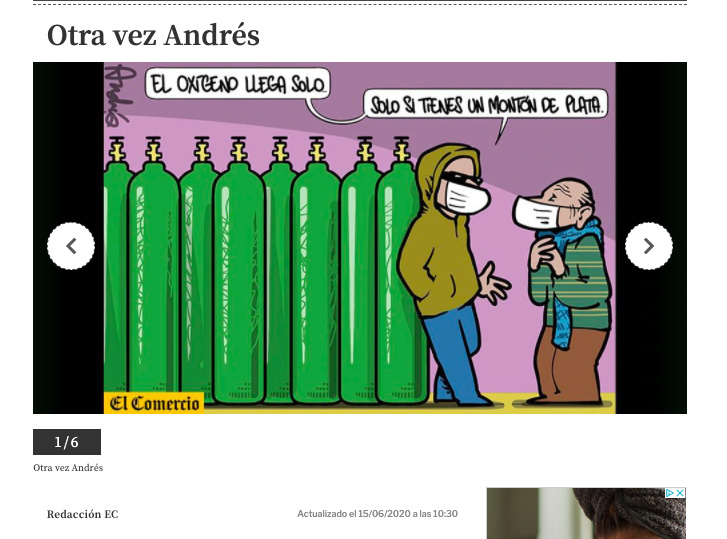
2020-06-16
The image title reads, "Oxígeno para loncheras/oxygen for lunchboxes," and states "solo si tienes un montón de plata/only if you have a ton of money." This implies, that like the U.S. medicine and healthcare can divide people along class lines, and the best medical care is available to those who can afford it.
-
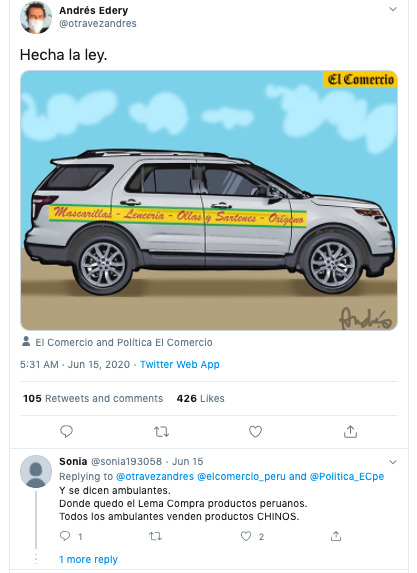
2020-06-15
A political cartoon about new restrictions on ambulatory sales. Prior to the pandemic, Peru had an economy where lots of people could purchase and sell products like ambulatory salespeople, moving around buses and neighborhoods freely carrying their products. Now however, salespeople aren't allowed to walk around or sell on foot, they have to sell out of their car. It offers some relief to those who actually have access to a car, but for those who don't and aren't earning money, the economic challenge of survival is a greater threat than the virus.
-
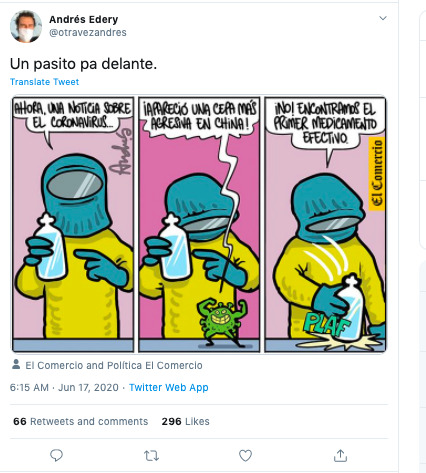
2020-06-17
A political cartoon reflecting on the recent news of a medical study in the UK that showed dexametasona (DECADRON) could help reduce the fatality rates of severe Coronavirus cases. The comments reflect some concern that readers might take this information too literally and self-medicate, which has been a problem in Peru. The self-medication approaches range from strange to devastating, as some have tried to create home spas or special chemical baths that proved fatal to users.
-
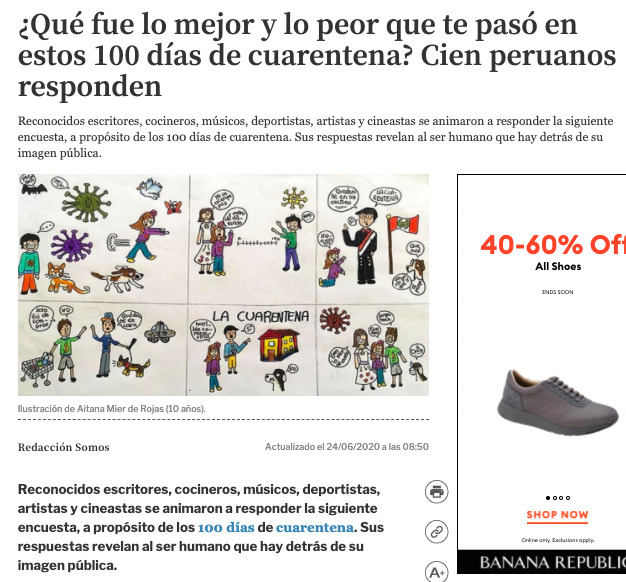
2020-06-24
I really love reading Somos, and I love this short historias piece reflecting on the best and worst of coronavirus from 100 Peruvians. It's reassuring to read what is helping people stay positive, and at the same time recognize that we're all struggling with a really difficult moment. There's a parent who laments she can't visit her daughter when she got into Stanford, another parent willing to watch the Wizard of Oz as many times as his daughter asks, and others who took the extra time at home to learn new skills like baking a carrot cake or reflecting on their lives and relationships.
-
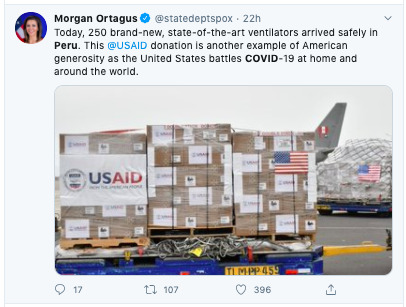
2020-06-24
I didn't realize there were organizations coordinating the production and distribution of medical supplies to send abroad, it seemed like just a few months ago we couldn't even get states to agree to share supplies. I'm wondering where these ventilators will go, or if they won't even make it out of Lima. The comments and replies seemed laudatory for the president, but nothing too significant, so I didn't screenshot them. Tweet text: Today, 250 brand-new, state-of-the-art ventilators arrived safely in Peru. This
@USAID donation is another example of American generosity as the United States battles COVID-19 at home and around the world.
-
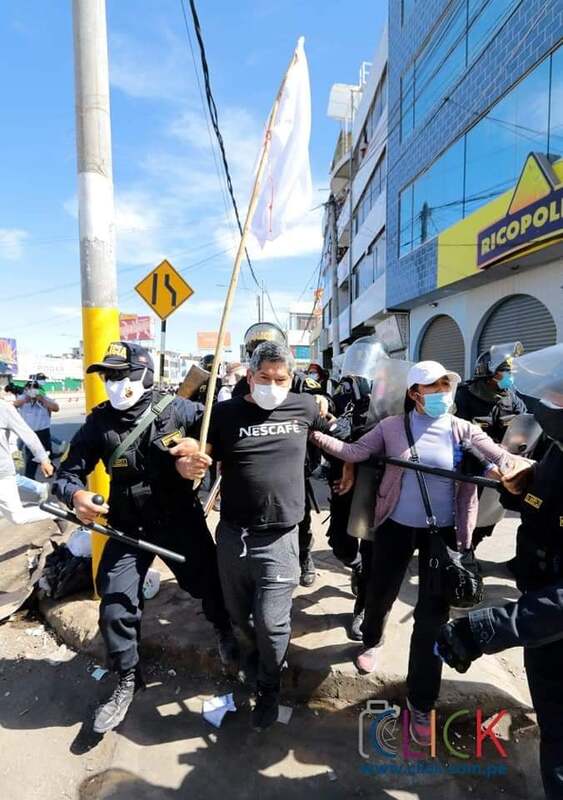
2020-06-18
En la ciudad de Arequipa Policías reprimieron a comerciantes de la plataforma Andres Avelino Cáceres el cual abastecía a la ciudad de verduras, frutas , carnes y demás alimentos así mismo allí trabajaban ambulantes, carretilleros, personal de limpieza entre otros. Ellos piden trabajar, luego de que el centro de abastos esté cerrado más de un mes y nadie puede tener acceso. Muchos no tienen de qué más vivir ya que no todos son mayoristas y algunos viven del trabajo diario.
-
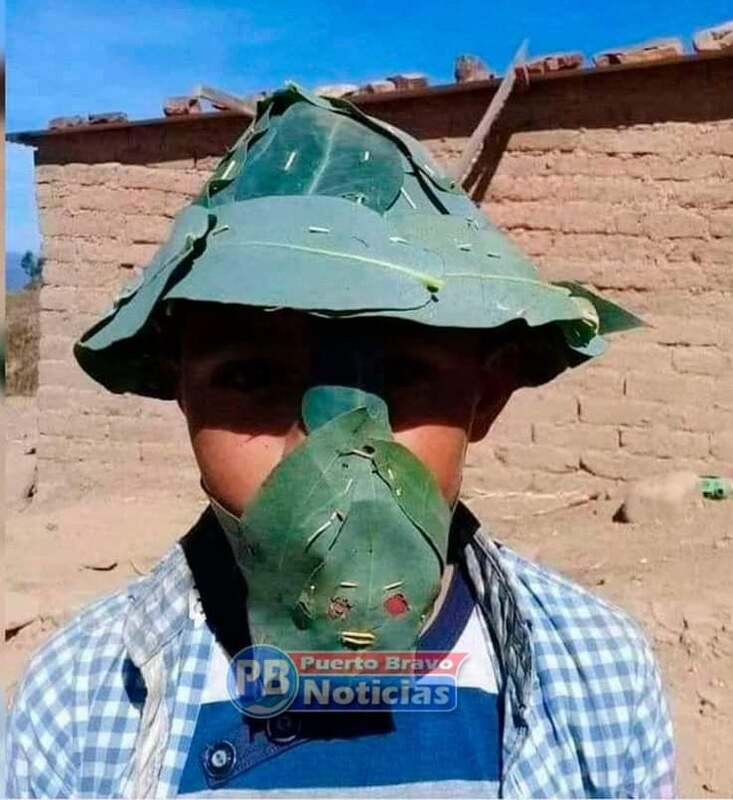
2020-06-18
NIÑO DE CHUQUIBAMBA ORGULLOSO LUCE SU MASCARILLA HECHA DE EUCALIPTO UNA PLANTA ANCESTRAL QUE SE UTILIZA PARA CURAR PROBLEMAS RESPIRATORIOS
Pese a las limitaciones, distancia, y los casi 3,000 m.s.n.m en el pueblo de Chuquibamba, los niños en vez de usar mascarillas, recurren por plantas medicinales.
En este caso, ellos mencionan que se sienten seguros de esa forma y dan ejemplo a muchas personas que no cumplen protocolos.
Fuente :Arequipa informa
-

2020-06-12
Peru has become a hotspot for coronavirus, despite an intense lockdown and track & trace technology. The article highlights that COVID-19 cases have overwhelmed Peru's hospitals and healthcare capacity, what's understated is that Peru did take the right measures, they did react correctly and with national leadership. The problem is that they could not sustain an extended quarantine period. If it had been a true quarantine and the borders were closed, things might look differently, but the U.S. and Peru took weeks to negotiate repatriation of citizens, and groups of migrants began returning to the countryside or leaving Peru for their homeland, such as in the case of Venezuelans. With all of that movement, it is impossible to control the spread of an infectious disease.
-
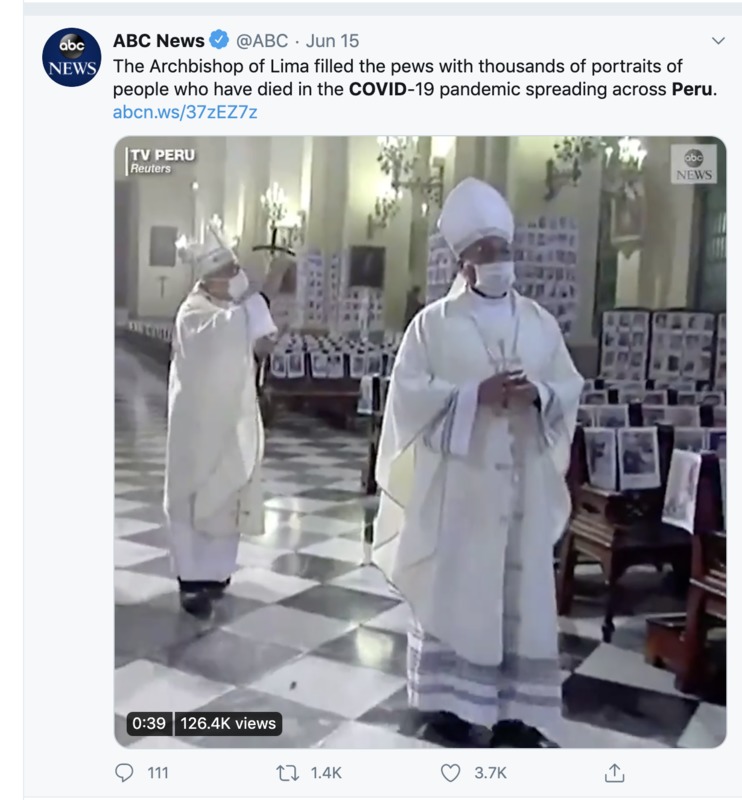
2020-06-15
This is a news clip from ABS News showing the archbishop of Peru blessing and making the sign of the cross over 1000s of photos representing people who have died from COVID-19 in Peru. It's sometimes so easy to feel like COVID isn't happening and that social distancing is blown out of proportion, or to question if we're overreacting. And then on seeing this video, all I feel is pain. So much pain for the lives lost, both young and old in what seems like a never-ending public health crisis.
-
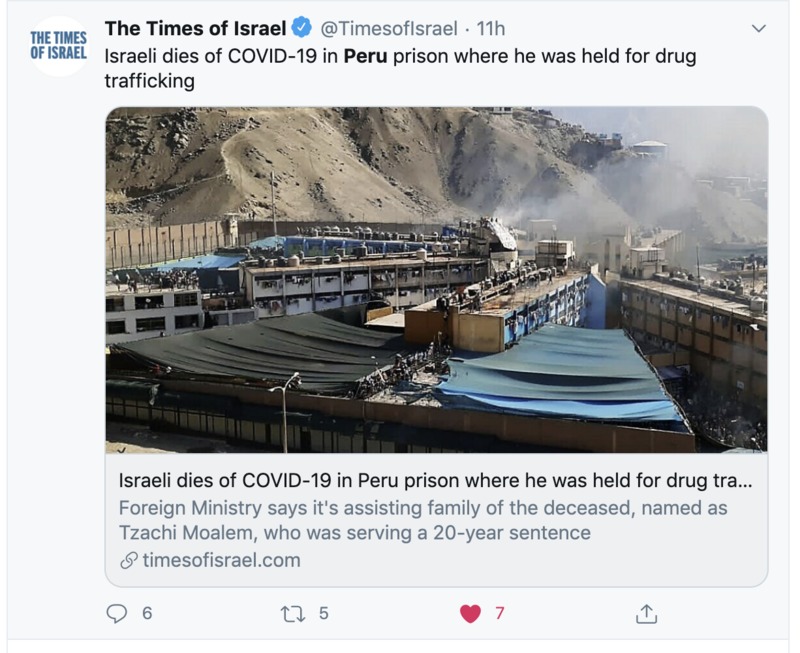
2020-06-16
This prison looks like a terrible place to serve a sentence, and even worse during a pandemic. The article discusses an Israeli inmate who died from Coronavirus while imprisoned in Lima, Peru. Sure, he was in jail for 20 years for trafficking cocaine, but it raises larger issues about the dire inequities and lack of funding present in Peruvian jails. Allegedly the woman, Hodaya Monsonego was mentally impaired, suggesting that perhaps she should have been repatriated to her family.
-
2020-06-12
Cientos de pobladores en el sector Huachhua Chopcca, en Huancavelica, secuestraron a 8 trabajadores de empresa de telefonía y quemaron antena que pensaban que era de 5G asegurando que transmite el Covid-19.
-

2020-06-12
Diariamente decenas de ancianos y mendigos, llegan hasta la sede del arzobispado en ma calle Santa Catalina, para conseguir un plato de comida ya que son personas en condición de abandono extrema pobreza, estas personas mencionan que no tienen trabajo por tanto no tienen para comer todo esto por culpa del gobierno y la pandemia.
 2021-05-26
2021-05-26 2021-07-22
2021-07-22 2021-03-18
2021-03-18 2021-03-16
2021-03-16 2021-03-16
2021-03-16 2021-02-18
2021-02-18 2021-01-27
2021-01-27 2021-01-21
2021-01-21 2020-11-25
2020-11-25 2020-10-20
2020-10-20 2020-10-31
2020-10-31 2020-10-13
2020-10-13 2020-10-12
2020-10-12 2020-08-06
2020-08-06 2020-09-06
2020-09-06 2020-03-06
2020-03-06 2020-08-22
2020-08-22 2020-09-14
2020-09-14 2020-08-16
2020-08-16 2020-08-16
2020-08-16 2020-08-12
2020-08-12 2020-08-18
2020-08-18 2020-08-28
2020-08-28 2020-08-28
2020-08-28 2020-08-30
2020-08-30 2020-08-22
2020-08-22 2020-08-15
2020-08-15 2020-07-22
2020-07-22 2020-07-22
2020-07-22 2020-07-19
2020-07-19 2020-07-07
2020-07-07 2020-07-08
2020-07-08 2020-07-09
2020-07-09 2020-07
2020-07 2020-06-29
2020-06-29 2020-06-26
2020-06-26 2020-06-23
2020-06-23 2020-06-16
2020-06-16 2020-06-15
2020-06-15 2020-06-17
2020-06-17 2020-06-24
2020-06-24 2020-06-24
2020-06-24 2020-06-18
2020-06-18 2020-06-18
2020-06-18 2020-06-12
2020-06-12 2020-06-15
2020-06-15 2020-06-16
2020-06-16 2020-06-12
2020-06-12